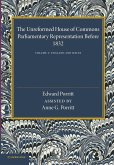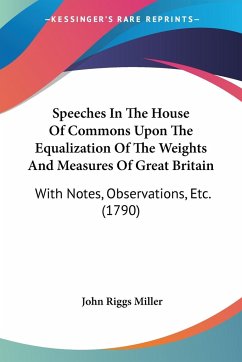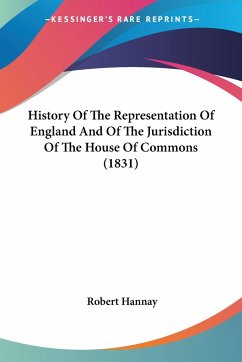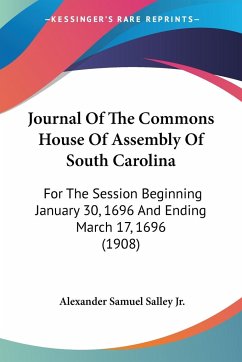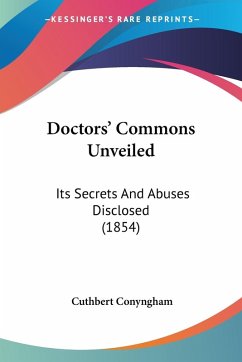Annie G. Porritt
The Unreformed House of Commons
Volume 2, Scotland and Ireland: Parliamentary Representation Before 1831
Annie G. Porritt
The Unreformed House of Commons
Volume 2, Scotland and Ireland: Parliamentary Representation Before 1831
- Broschiertes Buch
- Merkliste
- Auf die Merkliste
- Bewerten Bewerten
- Teilen
- Produkt teilen
- Produkterinnerung
- Produkterinnerung
Originally published in 1903, this two-volume work examines the changes in Parliamentary representation in England, Wales, Scotland and Ireland.
Andere Kunden interessierten sich auch für
![The Unreformed House of Commons The Unreformed House of Commons]() Annie G. PorrittThe Unreformed House of Commons47,99 €
Annie G. PorrittThe Unreformed House of Commons47,99 €![The House of Commons 1604-1629 The House of Commons 1604-1629]() Andrew ThrushThe House of Commons 1604-162944,99 €
Andrew ThrushThe House of Commons 1604-162944,99 €![The House Of Commons The House Of Commons]() Reginald Francis D. PalgraveThe House Of Commons23,99 €
Reginald Francis D. PalgraveThe House Of Commons23,99 €![Speeches In The House Of Commons Upon The Equalization Of The Weights And Measures Of Great Britain Speeches In The House Of Commons Upon The Equalization Of The Weights And Measures Of Great Britain]() John Riggs MillerSpeeches In The House Of Commons Upon The Equalization Of The Weights And Measures Of Great Britain24,99 €
John Riggs MillerSpeeches In The House Of Commons Upon The Equalization Of The Weights And Measures Of Great Britain24,99 €![History Of The Representation Of England And Of The Jurisdiction Of The House Of Commons (1831) History Of The Representation Of England And Of The Jurisdiction Of The House Of Commons (1831)]() Robert HannayHistory Of The Representation Of England And Of The Jurisdiction Of The House Of Commons (1831)31,99 €
Robert HannayHistory Of The Representation Of England And Of The Jurisdiction Of The House Of Commons (1831)31,99 €![Journal Of The Commons House Of Assembly Of South Carolina Journal Of The Commons House Of Assembly Of South Carolina]() Journal Of The Commons House Of Assembly Of South Carolina20,99 €
Journal Of The Commons House Of Assembly Of South Carolina20,99 €![Doctors' Commons Unveiled Doctors' Commons Unveiled]() Cuthbert ConynghamDoctors' Commons Unveiled21,99 €
Cuthbert ConynghamDoctors' Commons Unveiled21,99 €-
-
-
Originally published in 1903, this two-volume work examines the changes in Parliamentary representation in England, Wales, Scotland and Ireland.
Hinweis: Dieser Artikel kann nur an eine deutsche Lieferadresse ausgeliefert werden.
Hinweis: Dieser Artikel kann nur an eine deutsche Lieferadresse ausgeliefert werden.
Produktdetails
- Produktdetails
- Verlag: Cambridge University Press
- Seitenzahl: 600
- Erscheinungstermin: 14. Mai 2014
- Englisch
- Abmessung: 244mm x 170mm x 32mm
- Gewicht: 1020g
- ISBN-13: 9781107641617
- ISBN-10: 1107641616
- Artikelnr.: 41608859
- Herstellerkennzeichnung
- Libri GmbH
- Europaallee 1
- 36244 Bad Hersfeld
- gpsr@libri.de
- Verlag: Cambridge University Press
- Seitenzahl: 600
- Erscheinungstermin: 14. Mai 2014
- Englisch
- Abmessung: 244mm x 170mm x 32mm
- Gewicht: 1020g
- ISBN-13: 9781107641617
- ISBN-10: 1107641616
- Artikelnr.: 41608859
- Herstellerkennzeichnung
- Libri GmbH
- Europaallee 1
- 36244 Bad Hersfeld
- gpsr@libri.de
Part V. The Scotch Parliamentary System: 31. The political condition of Scotland after the union
32. The settlement of the representation at the union
33. The convention of royal burghs
34. Burgh representation in the Scotch parliament
35. The franchise in the counties
36. The non-elected members of the Scotch parliament
37. Usages and procedure
38. Burgh representation at Westminster
39. County representation after the union
Part VI. Parliamentary Representation in Ireland: 40. Introductory
41. County representation from the revolution to the re-enfranchisement of the Roman Catholics
42. The franchise withheld from the Roman Catholics
43. Catholic enfranchisement
44. The county franchise at the union
45. Borough representation from the revolution to the union - the corporation boroughs
46. The freeman boroughs
47. The potwalloper and manor boroughs
48. Boroughs as property
49. The representation of Trinity College
50. Dublin as a political capital
51. The organisation of the House of Commons
52. The speakership
53. Usages and procedure
54. Poynings' law
55. The relation of the Commons to the Lords
56. Relations of the House of Commons with the outside world
57. The Union.
32. The settlement of the representation at the union
33. The convention of royal burghs
34. Burgh representation in the Scotch parliament
35. The franchise in the counties
36. The non-elected members of the Scotch parliament
37. Usages and procedure
38. Burgh representation at Westminster
39. County representation after the union
Part VI. Parliamentary Representation in Ireland: 40. Introductory
41. County representation from the revolution to the re-enfranchisement of the Roman Catholics
42. The franchise withheld from the Roman Catholics
43. Catholic enfranchisement
44. The county franchise at the union
45. Borough representation from the revolution to the union - the corporation boroughs
46. The freeman boroughs
47. The potwalloper and manor boroughs
48. Boroughs as property
49. The representation of Trinity College
50. Dublin as a political capital
51. The organisation of the House of Commons
52. The speakership
53. Usages and procedure
54. Poynings' law
55. The relation of the Commons to the Lords
56. Relations of the House of Commons with the outside world
57. The Union.
Part V. The Scotch Parliamentary System: 31. The political condition of Scotland after the union
32. The settlement of the representation at the union
33. The convention of royal burghs
34. Burgh representation in the Scotch parliament
35. The franchise in the counties
36. The non-elected members of the Scotch parliament
37. Usages and procedure
38. Burgh representation at Westminster
39. County representation after the union
Part VI. Parliamentary Representation in Ireland: 40. Introductory
41. County representation from the revolution to the re-enfranchisement of the Roman Catholics
42. The franchise withheld from the Roman Catholics
43. Catholic enfranchisement
44. The county franchise at the union
45. Borough representation from the revolution to the union - the corporation boroughs
46. The freeman boroughs
47. The potwalloper and manor boroughs
48. Boroughs as property
49. The representation of Trinity College
50. Dublin as a political capital
51. The organisation of the House of Commons
52. The speakership
53. Usages and procedure
54. Poynings' law
55. The relation of the Commons to the Lords
56. Relations of the House of Commons with the outside world
57. The Union.
32. The settlement of the representation at the union
33. The convention of royal burghs
34. Burgh representation in the Scotch parliament
35. The franchise in the counties
36. The non-elected members of the Scotch parliament
37. Usages and procedure
38. Burgh representation at Westminster
39. County representation after the union
Part VI. Parliamentary Representation in Ireland: 40. Introductory
41. County representation from the revolution to the re-enfranchisement of the Roman Catholics
42. The franchise withheld from the Roman Catholics
43. Catholic enfranchisement
44. The county franchise at the union
45. Borough representation from the revolution to the union - the corporation boroughs
46. The freeman boroughs
47. The potwalloper and manor boroughs
48. Boroughs as property
49. The representation of Trinity College
50. Dublin as a political capital
51. The organisation of the House of Commons
52. The speakership
53. Usages and procedure
54. Poynings' law
55. The relation of the Commons to the Lords
56. Relations of the House of Commons with the outside world
57. The Union.


